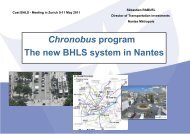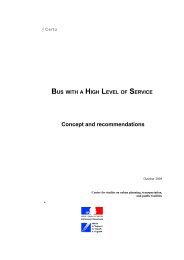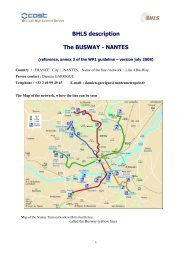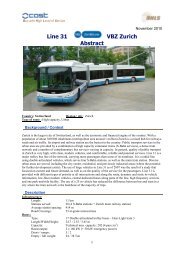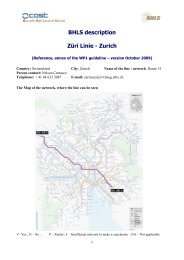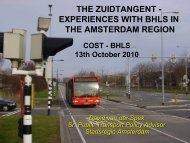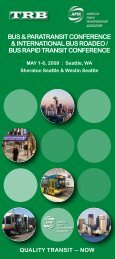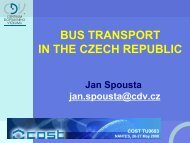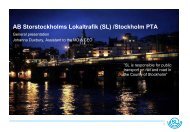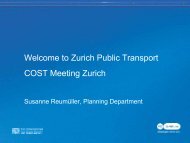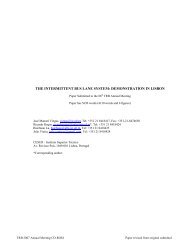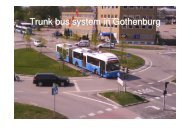What quality and capacity can bus systems achieve in Europe? 1
What quality and capacity can bus systems achieve in Europe? 1
What quality and capacity can bus systems achieve in Europe? 1
Create successful ePaper yourself
Turn your PDF publications into a flip-book with our unique Google optimized e-Paper software.
Big changes for the <strong>bus</strong><br />
François Rambaud, Project Manager - Network design <strong>and</strong> management,<br />
Certu, Lyon, France &<br />
Carlos Cristóbal-P<strong>in</strong>to, Head of Studies <strong>and</strong> Plann<strong>in</strong>g Department<br />
(Jefe del Área de Estudios y Planificación), CRTM, Madrid, Spa<strong>in</strong><br />
<strong>What</strong> <strong>quality</strong> <strong>and</strong> <strong>capacity</strong> <strong>can</strong> <strong>bus</strong> <strong>systems</strong><br />
<strong>achieve</strong> <strong>in</strong> <strong>Europe</strong>? 1<br />
Left: Lorient: a 2.5 km common section that prioritises all l<strong>in</strong>es operat<strong>in</strong>g <strong>in</strong> the centre<br />
Right: Castellon: the guided <strong>bus</strong> <strong>in</strong> a well identified <strong>in</strong>frastructure<br />
The first known Bus Rapid Transit (BRT) system was launched <strong>in</strong> Curitiba, Brazil <strong>in</strong> 1974 as a means of offer<strong>in</strong>g efficient <strong>and</strong><br />
effective <strong>bus</strong> travel with<strong>in</strong> the fast exp<strong>and</strong><strong>in</strong>g city...<br />
After other efficient examples<br />
such as those found <strong>in</strong> Ottawa,<br />
Canada (s<strong>in</strong>ce 1983) or <strong>in</strong> Quito,<br />
Ecuador (s<strong>in</strong>ce 1994), which <strong>in</strong>tegrated<br />
much more ITS, the US have written <strong>and</strong><br />
launched the Bus Rapid Transit concept<br />
<strong>in</strong> 2004 (with a new version <strong>in</strong> 2009)<br />
as a method for underst<strong>and</strong><strong>in</strong>g <strong>and</strong> improv<strong>in</strong>g<br />
such trends all over the world,<br />
both <strong>in</strong> develop<strong>in</strong>g countries, as well as<br />
for themselves <strong>and</strong> <strong>in</strong> developed countries.<br />
The well-known BRT with the highest<br />
<strong>capacity</strong> at this time <strong>can</strong> be seen<br />
<strong>in</strong> Bogotá, Colombia. It is called Transmilenio<br />
<strong>and</strong> was developed <strong>in</strong> 2000.<br />
It now boasts a network of 85km, with<br />
some impressive <strong>bus</strong> flows.<br />
BRT is seen as a means of offer<strong>in</strong>g high<br />
levels of service, similar to that of light<br />
rail but at a fraction of the cost, through<br />
a system based approach to <strong>bus</strong> travel.<br />
For what market, for what k<strong>in</strong>d of city, is<br />
this concept most suitable <strong>and</strong> affordable?<br />
And does or <strong>can</strong> this concept really<br />
compete with the rail market? These are<br />
several hot issues which <strong>can</strong>not have<br />
the same answers everywhere <strong>in</strong> the<br />
world…<br />
Throughout <strong>Europe</strong>, <strong>bus</strong> improvements<br />
have followed similar pr<strong>in</strong>ciples:<br />
<strong>in</strong> Sweden (as a ‘trunk network’ <strong>in</strong><br />
Stockholm), <strong>in</strong> Engl<strong>and</strong> <strong>and</strong> <strong>in</strong> Irel<strong>and</strong><br />
(under the name of ‘Quality Bus Corridor’),<br />
<strong>in</strong> France (BHNS – ‘Bus à Haut<br />
Niveau de Service’), <strong>in</strong> Germany <strong>and</strong> <strong>in</strong><br />
Spa<strong>in</strong> (the Metro<strong>bus</strong> concept), <strong>and</strong> <strong>in</strong><br />
the Netherl<strong>and</strong>s (HOV – ‘Hoogwaardig<br />
Openbaar Vervoer’; high <strong>quality</strong> public<br />
transport).<br />
In order to underst<strong>and</strong> how it is applied<br />
<strong>and</strong> could best be applied to the <strong>Europe</strong>an<br />
urban <strong>and</strong> economical context, a<br />
COST 2 Action, called ‘Buses with a high<br />
level of service, Fundamental characteristics<br />
<strong>and</strong> recommendations for decision-mak<strong>in</strong>g<br />
<strong>and</strong> research’ has been<br />
approved <strong>in</strong> April 2007 <strong>and</strong> will last until<br />
October 2011.<br />
With<strong>in</strong> a group of 14 countries 3 <strong>in</strong>volved,<br />
our objective is ma<strong>in</strong>ly to share<br />
our current state of the art know-how<br />
<strong>in</strong> this field, the key f<strong>in</strong>d<strong>in</strong>gs as well<br />
as the limits <strong>and</strong> difficulties to launch<br />
such BHLS projects <strong>in</strong> <strong>Europe</strong>. We<br />
need to underst<strong>and</strong> better the key<br />
components of efficient <strong>and</strong> attractive<br />
‘system’ approaches.<br />
This COST action is split <strong>in</strong>to four Work<br />
Packages (WP) <strong>and</strong> four Work<strong>in</strong>g Groups<br />
(WG) represented <strong>in</strong> the chart on p.23.<br />
The three first WGs cover all the system<br />
components, while the fourth deals with<br />
assessment issues <strong>and</strong> the different impacts<br />
of the whole system.<br />
Four plenary meet<strong>in</strong>gs with technical visits<br />
have already been organised: <strong>in</strong> Dubl<strong>in</strong>,<br />
<strong>in</strong> Nantes (with a visit to the Triskell<br />
<strong>in</strong> Lorient <strong>and</strong> also to the Trans-Val-de-<br />
Marne, which extends to Paris), <strong>in</strong> Madrid<br />
(with a visit to the guided trolley<strong>bus</strong> <strong>in</strong><br />
Castellón), <strong>and</strong> last but not least <strong>in</strong> Sweden<br />
(Stockholm, Jönköp<strong>in</strong>g <strong>and</strong> Lund).<br />
22 PTI September/October 2009
Big changes for the <strong>bus</strong><br />
Dur<strong>in</strong>g these workshops a great diversity<br />
of <strong>systems</strong> was observed, as follows:<br />
Dubl<strong>in</strong> (1.2 million <strong>in</strong>habitants) has<br />
launched, s<strong>in</strong>ce several years, an impressive<br />
network of several Quality Bus<br />
Corridors (QBC) on the ma<strong>in</strong> arteries<br />
of the whole urban area. The aim is to<br />
provide 400km of QBC compared to the<br />
first 200km already carried out (annual<br />
<strong>in</strong>vestment of EUR 30 million - EUR 40<br />
million until 2011). The <strong>bus</strong>es do not<br />
have a specific design. The great results<br />
they got, however, (better regularity<br />
<strong>and</strong> speed) allowed them to <strong>in</strong>crease<br />
their frequency <strong>and</strong> attractiveness (on<br />
all QBC, around 16% of the trips come<br />
from cars). After work<strong>in</strong>g on <strong>in</strong>frastructure<br />
itself at a large scale, the objective<br />
is now to soon implement a dynamic<br />
<strong>in</strong>formation system for passengers (real<br />
time data).<br />
Nantes (0.6 million <strong>in</strong>habitants) has<br />
chosen the Busway as its fourth ma<strong>in</strong><br />
l<strong>in</strong>e, a <strong>bus</strong> implemented exactly like the<br />
three exist<strong>in</strong>g tramway l<strong>in</strong>es, with right<br />
of way, priority at all cross<strong>in</strong>gs, ticket<strong>in</strong>g<br />
mach<strong>in</strong>es at all stations, <strong>and</strong> obviously<br />
an enhancement of the whole urban<br />
space between hous<strong>in</strong>g. The whole<br />
cost reaches EUR 7 million/km, a third<br />
of a tram l<strong>in</strong>e. Opened s<strong>in</strong>ce November<br />
2006 with a very high frequency (3.5<br />
m<strong>in</strong>), this l<strong>in</strong>e is well identified <strong>and</strong><br />
has gone beyond the prevision, 26,500<br />
passengers/day for an only 7km long<br />
l<strong>in</strong>e. Bi-articulated <strong>bus</strong>es will soon be<br />
requested.<br />
Lorient (0.2 million <strong>in</strong>habitants) is the<br />
ma<strong>in</strong> city of an urban area too small for<br />
launch<strong>in</strong>g a hierarchised network with<br />
feeder <strong>bus</strong> l<strong>in</strong>es on a heavy tram l<strong>in</strong>e.<br />
A project of three enhanced <strong>bus</strong> corridors<br />
(called the Triskell) has been carried<br />
out without chang<strong>in</strong>g the exist<strong>in</strong>g<br />
<strong>bus</strong> network. While improv<strong>in</strong>g walk<strong>in</strong>g<br />
<strong>and</strong> bike modes, this project was led by<br />
these three ma<strong>in</strong> objectives: the <strong>bus</strong> be<strong>in</strong>g<br />
direct, clearly identified, <strong>and</strong> always<br />
hav<strong>in</strong>g first right of way as often as possible<br />
(through crossroads <strong>and</strong> reserved<br />
platform <strong>in</strong> the city centre, <strong>and</strong> virtual<br />
<strong>bus</strong> l<strong>in</strong>es <strong>in</strong> other areas).<br />
Paris (Region: 11.6 million <strong>in</strong>habitants)<br />
offers the highest <strong>capacity</strong> <strong>bus</strong> l<strong>in</strong>e<br />
<strong>in</strong> France, called TVM (Trans-Val-de-<br />
Marne), which was launched <strong>in</strong> 1993.<br />
With its very recent western extension<br />
(July 2007), implemented with lots of<br />
improvements <strong>in</strong> <strong>in</strong>frastructure (better<br />
station concept), more clearly identified<br />
<strong>and</strong> new operat<strong>in</strong>g tools (camera control<br />
<strong>and</strong> priority at traffic lights) for the<br />
The four work<strong>in</strong>g packages of the COST project<br />
WG1<br />
Infrastructure<br />
WG2<br />
Roll<strong>in</strong>g-stock<br />
benefit of the whole l<strong>in</strong>e (decrease of<br />
fuel consumption by 6%), this suburban<br />
l<strong>in</strong>e now boasts an impressive length<br />
(20km), frequency (3-4m<strong>in</strong>) <strong>and</strong> load<br />
(around 65,000 passengers/day) whilst<br />
connect<strong>in</strong>g several RER <strong>in</strong>terchanges<br />
around the south of Paris.<br />
Madrid (Region: 6.4 million <strong>in</strong>habitants)<br />
launched an impressive <strong>and</strong> alternative<br />
BUS – VAO 4 lane <strong>in</strong> 1995, alongside the<br />
A-6 corridor, a novelty <strong>in</strong> <strong>Europe</strong>, provid<strong>in</strong>g<br />
both promotion of public transport,<br />
as well as a means to <strong>in</strong>crease car occupancy<br />
through <strong>in</strong>frastructure management.<br />
On this corridor, the car modal<br />
share has decreased from 55,6% down<br />
to 47,9%. The system is complemented<br />
with an underground <strong>bus</strong> term<strong>in</strong>al station,<br />
Moncloa, which is very well <strong>in</strong>tegrated<br />
with the metro network. Almost<br />
120,000 passengers/day use this corridor.<br />
Due to this success, a similar large<br />
<strong>in</strong>vestment program has been planned<br />
all around the metropolitan area (M<strong>bus</strong><br />
concept). The four expected l<strong>in</strong>es are estimated<br />
to cost around EUR 10-15 million<br />
per kilometer.<br />
Castellón (0.3 million <strong>in</strong>habitants) decided<br />
to structure its public transport<br />
network with two long guided trolley<strong>bus</strong><br />
l<strong>in</strong>es (22 <strong>and</strong> 18km) well marked with<strong>in</strong> a<br />
red contrasted <strong>in</strong>frastructure. The guid<strong>in</strong>g<br />
system chosen is optical like TEOR’s<br />
<strong>in</strong> Rouen. The first two kilometres were<br />
WG3<br />
Operat<strong>in</strong>g<br />
issues<br />
WP1 State of the art<br />
WG4<br />
Social,<br />
economical<br />
issues <strong>and</strong><br />
network<strong>in</strong>g<br />
Identification of the best practices, case studies regard<strong>in</strong>g the system<br />
WP2 Analysis of the state of the art<br />
WG reports for each WG topic<br />
WP3 Recomm<strong>and</strong>ations<br />
WG reports for each WG topic - f<strong>in</strong>al report<br />
WP4 Dissem<strong>in</strong>ation<br />
Website - f<strong>in</strong>al conference<br />
opened <strong>in</strong> June 2008, connect<strong>in</strong>g the<br />
university with the railway station. Efficient<br />
<strong>and</strong> regular gaps were observed.<br />
Stockholm (1.9 million <strong>in</strong>habitants)<br />
launched <strong>in</strong> 1992 a <strong>bus</strong>-based trunk<br />
network of four l<strong>in</strong>es, restructur<strong>in</strong>g the<br />
whole central area. The average <strong>bus</strong><br />
speed was previously 13km/h. The <strong>bus</strong><br />
l<strong>in</strong>es have been strengthened <strong>and</strong> have<br />
been called by easy numbers to remember:<br />
L<strong>in</strong>es one to four. Previously,<br />
between 24,000 <strong>and</strong> 35,000 passengers/day<br />
were carried, whereas now<br />
there are between 23,000 <strong>and</strong> 57,000<br />
at an average speed of 15km/h. More<br />
than half of the new passengers come<br />
from the metro, <strong>and</strong> 5% from the car. A<br />
good identification of the system (blue<br />
<strong>bus</strong>es) with a better offer (frequency<br />
<strong>and</strong> schedule span) <strong>can</strong> provide higher<br />
ridership, even if the <strong>in</strong>frastructure is<br />
not totally dedicated <strong>and</strong> the cross<strong>in</strong>gs<br />
were neither all prioritised, nor exclusively<br />
dedicated, nor were the cross<strong>in</strong>gs<br />
all right-of-way ones.<br />
Jönköp<strong>in</strong>g (County: 0.3 million <strong>in</strong>habitants),<br />
located <strong>in</strong> the middle of Sweden’s<br />
three largest cities (Stockholm,<br />
Göteborg <strong>and</strong> Malmö), is built around<br />
three lakes. Hence it was complicated<br />
to deal with both transportation <strong>and</strong><br />
urbanism. To solve mobility problems,<br />
a new master plan <strong>in</strong>tegrated a hierarchised<br />
<strong>bus</strong> network, with two ma<strong>in</strong><br />
September/October 2009<br />
PTI<br />
23
Big changes for the <strong>bus</strong><br />
Left: Jönköp<strong>in</strong>g: the central station, where the 3 structured l<strong>in</strong>es converge<br />
Right: Utrecht: bi-articulated <strong>bus</strong>es, <strong>in</strong> a well contrasted, dedicated lane s<strong>in</strong>ce 2003<br />
BHLS l<strong>in</strong>es (a yellow one <strong>and</strong> a red<br />
one) that cross the centre s<strong>in</strong>ce 1996.<br />
A third (green) l<strong>in</strong>e was started <strong>in</strong> 2001<br />
<strong>in</strong> order to complete the network. An<br />
efficient global approach has been<br />
<strong>achieve</strong>d, with right of way <strong>and</strong> ITS<br />
s<strong>in</strong>ce 1997 (wait<strong>in</strong>g time for next departure<br />
is given at stops <strong>and</strong> priority<br />
granted at all cross<strong>in</strong>gs).<br />
Lund (0.1 million <strong>in</strong>habitants), which<br />
has 35,000 students, has set up a<br />
strategy for a susta<strong>in</strong>able transport<br />
system by 2030. The <strong>bus</strong> l<strong>in</strong>e called<br />
‘Lundalänken’ (Lund l<strong>in</strong>k) has been<br />
strengthened with <strong>in</strong>frastructure<br />
measures encourag<strong>in</strong>g BHLS l<strong>in</strong>es offer<strong>in</strong>g<br />
a high level of service. Started<br />
<strong>in</strong> 2003, this l<strong>in</strong>e doubled its ridership<br />
<strong>in</strong> three years, <strong>and</strong> today carries 6,000<br />
passengers/day. The l<strong>in</strong>e cost EUR 20<br />
million for 6km, with dedicated lanes<br />
only if needed. This <strong>in</strong>frastructure design<br />
has <strong>in</strong>tegrated ‘tram’ specifications,<br />
so that a tramway <strong>can</strong> easily be<br />
built on this platform <strong>in</strong> case of higher<br />
ridership <strong>in</strong> the future: the bridges are<br />
high enough, the holds wide enough<br />
<strong>and</strong> so on.<br />
Gothenburg (1.5 million <strong>in</strong>habitants)<br />
had a too low level of public transport<br />
modal share (24% of the motorised<br />
trips). The city already had 11 tram<br />
l<strong>in</strong>es, to which four <strong>bus</strong> trunk l<strong>in</strong>es<br />
were added. The idea of launch<strong>in</strong>g<br />
a BHLS network with bi-articulated<br />
<strong>bus</strong>es was born because of a lack of<br />
money. They now carry: 24,000 passengers/day<br />
with 3m<strong>in</strong> headway at<br />
peak hours on L<strong>in</strong>e 16; 10,000 passengers/day<br />
with 5m<strong>in</strong> headway for<br />
L<strong>in</strong>e 17; <strong>and</strong> 20,000 passengers/day<br />
for L<strong>in</strong>es 18+19 with headways of<br />
5 m<strong>in</strong>.<br />
Some key po<strong>in</strong>ts <strong>can</strong> be highlighted:<br />
• Successful BHLS projects require<br />
lengthy dialogue; the issue of choos<strong>in</strong>g<br />
the right mode rema<strong>in</strong>s fundamental.<br />
As a mode, the <strong>bus</strong> appears<br />
flexible <strong>and</strong> well-adapted to new or<br />
exp<strong>and</strong>ed urban zones (e.g. Evry <strong>in</strong><br />
France, Almere <strong>in</strong> the Netherl<strong>and</strong>s<br />
<strong>and</strong> the Fastrack project southeast of<br />
London).<br />
• Buses allow a variety of configurations:<br />
from high-volume primary<br />
routes fed by secondary services<br />
through to trunk sections shared by<br />
several routes <strong>in</strong> order to m<strong>in</strong>imise<br />
transfers. However, there are no<br />
traces of the express services that<br />
are so widely developed <strong>in</strong> high<strong>capacity</strong><br />
projects on the other side<br />
of the Atlantic.<br />
• Some BHLS projects are designed to<br />
be upgraded <strong>in</strong> future <strong>in</strong>to tramway<br />
<strong>systems</strong> once there is sufficient dem<strong>and</strong>.<br />
<strong>Europe</strong>’s economic context<br />
<strong>and</strong> labour costs appear to favour<br />
tramway for upwards of 30,000 to<br />
50,000 trips/day <strong>and</strong> for volumes of<br />
over 2,000 to 2,800 passengers per<br />
hour on the grounds of comfort <strong>and</strong><br />
urban <strong>in</strong>tegration.<br />
• The projects are beg<strong>in</strong>n<strong>in</strong>g to show<br />
signs of high-<strong>quality</strong> <strong>in</strong>tegration; the<br />
exclusive <strong>bus</strong>ways are easily passable<br />
<strong>in</strong> order to promote cycl<strong>in</strong>g <strong>and</strong><br />
walk<strong>in</strong>g. It then becomes difficult to<br />
go beyond three-m<strong>in</strong>ute headways <strong>in</strong><br />
order to ma<strong>in</strong>ta<strong>in</strong> satisfactory service<br />
consistency.<br />
• A <strong>bus</strong> market specifically for BHLS<br />
appears to be emerg<strong>in</strong>g: this needs<br />
to be recognisable <strong>and</strong> provide the<br />
level of comfort <strong>and</strong> <strong>in</strong>formation of<br />
a structur<strong>in</strong>g corridor. The bi-articulated<br />
vehicle also appears to have its<br />
place <strong>in</strong> <strong>Europe</strong>.<br />
In conclusion, BHLS has a highly promis<strong>in</strong>g<br />
market <strong>in</strong> <strong>Europe</strong> <strong>in</strong> small towns,<br />
medium-sized conurbations as well as<br />
<strong>in</strong> the outly<strong>in</strong>g zones of the biggest metropolitan<br />
areas.<br />
Until its expected publication <strong>in</strong> 2011,<br />
do stay <strong>in</strong> contact through the website<br />
www.bhls.eu 5 , where you will f<strong>in</strong>d,<br />
amongst other <strong>in</strong>formation, all the presentations<br />
of the plenary workshops that<br />
have been <strong>and</strong> will be organised.<br />
1 Article made from the COST action TU 0603<br />
framework, ‘Buses with a high level of service’<br />
- www.bhls.eu<br />
2 COST is an <strong>in</strong>tergovernmental <strong>Europe</strong>an<br />
framework for <strong>in</strong>ternational cooperation between<br />
nationally funded research activities.<br />
COST activities are endorsed by the FP7. For<br />
further <strong>in</strong>formation, see www.cost.esf.org<br />
3 Participat<strong>in</strong>g countries: Belgium, Czech Republic,<br />
France, Germany, Greece, Irel<strong>and</strong>,<br />
Italy, Netherl<strong>and</strong>s, Portugal, Romania, Spa<strong>in</strong>,<br />
Sweden, Switzerl<strong>and</strong> <strong>and</strong> United K<strong>in</strong>gdom.<br />
4 A VAO or HOV lane: High Occupancy Vehicle<br />
highway lane i.e. for cars with more than one<br />
person.<br />
5 The first leaflet <strong>can</strong> be downloaded at http://<br />
www.bhls.eu/IMG/pdf/bhls_nl1_gb_web.pdf<br />
Contact:<br />
Francois.Rambaud@developpementdurable.gouv.fr<br />
<strong>and</strong><br />
carlos.cristobal@ctm-comadrid.com<br />
copy<strong>in</strong>g editor@uitp.org<br />
Partly translated from the French orig<strong>in</strong>al version<br />
24 PTI September/October 2009



